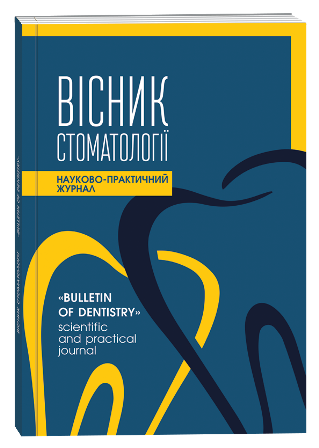ANALYSIS OF THE RESULTS OF X-RAY EXAMINATION OF BONE TISSUE IN PATIENTS WITH MANDIBULAR FRACTURES ON ADMISSION TO THE HOSPITAL
DOI:
https://doi.org/10.35220/2078-8916-2024-51-1.20Keywords:
mandibular fracture, orthopantomogram, mandibular cortical density, optical bone density, age, gender.Abstract
The aim of the study – to analyze the qualitative and quantitative state of bone tissue in patients with mandibular fractures on admission to the hospital. Research methods. Radiological examination was performed in 151 patients with mandibular fractures, aged 18-44 years: 92 patients (60.93%) were male and 59 patients (39.07%) were female. All patients underwent standard orthopantomograms on an «Orthophos XH» (Sirona) radiograph. For the qualitative characterization of the cortical layer of the mandible, the MCI index (mandibular cortical index) was used according to Klemrtt I E. and co-authors. The intensity of bone mineralization in the areas of mandibular fracture was determined by calculating the increase in bone tissue optical density on digital orthopantomograms using the «Image G» software. Scientific novelty. In the analysis of orthopantomograms of patients with mandibular fractures, using the MCI index, it was found that in both sexes, the C2 bone type prevailed, which was objectified in 62.25±3.94 % of the subjects, p<0.01. It should be noted that the mandibular cortical plate type C1 was diagnosed 1.4 times more often in men than in women with mandibular fractures (33.70±4.93 % vs. 23.73±5.53 %, p>0.05, respectively). Type C2 was found in almost the same number of patients of both sexes: 60.87±5.09 % of men and 64.41±6.23 % of women, p>0.05. At the same time, the type of mandibular cortical plate C3 was objectified 2.2 times more often in women than in men with traumatic lesions of the mandible (11.86±4.20 % vs. 5.43±1.36 %, p>0.05, respectively). In the age interval of 18-25 years, the optical density of the mandibular bone tissue was lower compared to the data in the control group: by 9.35% in men, p1>0.05, and by 14.14 % in women, p<0.05, p1>0.05. At the same time, in patients aged 26-35 years, the optical density of the mandibular bone tissue was lower compared to the data in the control group: in males – by 19.41 %, p<0.01, p2<0.05, and in females by 28.44%, p, p2<0.01, p1<0.05. In patients aged 36-44 years, the optical density of bone tissue was lower: in men – by 30.30 %, p, p2<0.01 and by 37.37 % and in women, p, p2<0.01, p1, p3<0.05. Conclusions. Thus, the study revealed that the type of mandibular cortical plate C1 was 1.4 times more often diagnosed in men than in women, and C3 was 2.2 times more often diagnosed in women than in men (11.86 % vs. 5.43 %, respectively). At the same time, the type of cortical lamina C2 was objectified in 60.87 % of men and 64.41% of women. The optical density of the mandibular bone tissue was on average 19.68 % lower in men and 26.18 % lower in women compared to the control group, p<0.01.
References
Маланчук В. О., Копчак А. В., Гордийчук М. А., Мамонов Р. О., Рибачук А. В., Кравчук М. Г. Травматичні переломи нижньої щелепи з 1995 по 2009 рр. (матеріали клініки кафедри). Вісник стоматології. 2015. № 1. С. 69-73.
Wusiman P., Maimaitituerxun B., Guli Saimaiti A., Moming A. Epidemiology and Pattern of Oral and Maxillofacial Trauma. The Journal of craniofacial surgery. 2020. № 31(5). e517–e520.
Аветіков Д. С., Локес К. П., Ставицький С. О. Переломи нижньої щелепи: аналіз частоти виникнення, локалізації та ускладнень. Вісник проблем біології і медицини. 2014. Вип. 3(3). С. 62–64.
Guo H. Q., Yang X., Wang X. T., Li S., Ji A. P., Bai J. Epidemiology of maxillofacial soft tissue injuries in an oral emergency department in Beijing: A twoyear retrospective study. Dental traumatology: official publication of International Association for Dental Traumatology. 2021.
Streubel S., O., Mirsky D., M. Craniomaxillofacial Trauma. Facial plastic surgery clinics of North America. 2016. № 24(4). Р. 605–617 https://doi.org/10.1016/ j,fsc,2016.06.014
Pan Y., Zhu H., Hou L. Epidemiological analysis and emergency nursing care of oral and craniomaxillofacial trauma: a narrative review. Annals of palliative medicine. 2022. № 11(4). Р. 1518–1525 https://doi.org/10.21037/ apm-21-2995
Swetah Vane C. S., Thenmozhi M. S. Mandibular fracture: an analysis of vulnerable fracture points, types and management methods. J. Pharm. Sci. & Res. 2015. Vol. 7 (9). P. 714– 717.
Хірургічна стоматологія та щелепно-лицева хірургія: підручник: / Маланчук В. О., Логвіненко І. П., Маланчук Т. О. та ін. Київ: ЛОГОС, 2011. 607 с.
Bykowski P. N., James M. R., Daniali I. B., L. N., Clavijo-Alvarez, J. A. The Epidemiology of Mandibular Fractures in the United States, Part 1: A Review of 13,142 Cases from the US National Trauma Data Bank. Journal of Oral and Maxillofacial Surgery. 2015. № 73(12). Р. 2361–2366.
Рибалов О. В., Ахмеров В. Д. Ускладнення травматичних пошкоджень щелепно-лицевої області: (навч. – метод. посіб. для студ. стомат. факульт. вищих мед. навч. закладів IV рівнів акредитації та інтернів-стоматологів). Полтава, ТОВ «Фірма «Техсервіс»», 2011. 169 c.
Munhoz L, Morita L, Nagai AY, Moreira J, Arita ES. Mandibular cortical index in the screening of postmenopausal at low mineral density risk: a systematic review. Dentomaxillofac Radiol. 2021. Vol. 50. № 4. – 20200514. doi:10.1259/dmfr.20200514
Oliveira M.R., Gonçalves A., Gabrielli M.A.C., de Andrade C.R., Scardueli C.R., Pereira Filho V.A. The correlation of different methods for the assessment of bone quality in vivo: an observational study. Int J Oral Maxillofac Surg. – 2022. – Vol. 51. № 3. – Р. 388-397. doi:10.1016/j.ijom.2021.05.019
Грузєва Т.С. Біостатистика. Вінниця : Нова книга, 2020. 384 с.









